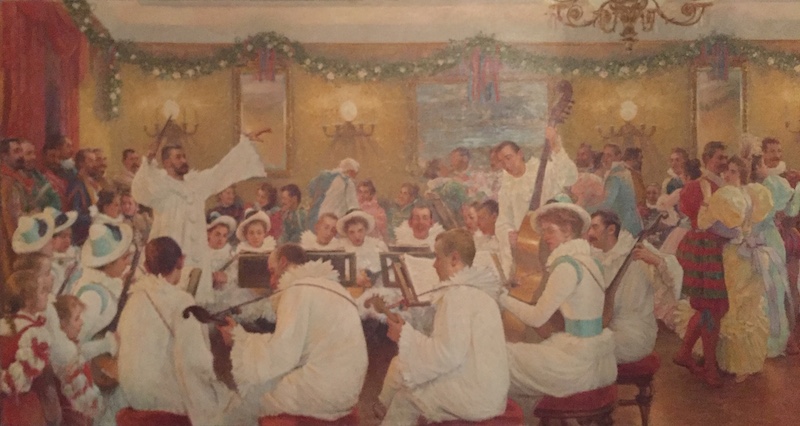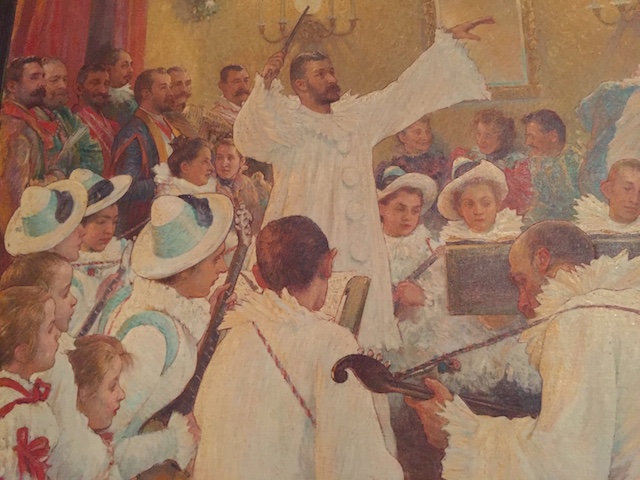Vlaho Bukovac, distinguished Croatian painter
This web page was born thanks to the following request of Mr Mark Nelson that I obtained in February 1998:
I am interested in any information you might have on Vlaho Bukovac, particularly the painting "Isus prijatelj malenih" (Paris 1888). I did a search for him and your art website came up ... I'm interested in prints of this painting or any info. you might have about him or the Gallery of Fine Arts in Dubrovnik. I appreciate your help in this matter.
mnelson@1st.net or woodcraft@hotmail or maxmarket.com/nelson
This mail has been proceded to Mr Vjekoslav Pavic, Zagreb, and here is the answer he prepared:
Dear Mr. Mark Nelson,
Relating to your request on Vlaho Bukovac we have prepared some information found in the following literature:
- Vera Kruzic-Uchytil: Vlaho Bukovac - zivot i djelo (Vlaho Bukovac -life and work), Matica Hrvatska, Zagreb, 1968 - based on doctoral thesis presented at the Faculty of Arts in Zagreb on December 22, 1964.
- Enciklopedija likovnih umjetnosti (Encyclopaedia of Fine Arts), Vol.1, Jugoslavenski leksikografski zavod, Zagreb, 1959.
- Enciklopedija Leksikografskog zavoda, ( Encyclopaedia of the Lexicographic Institute), Vol.1, Jugoslavenski leksikografski zavod, Zagreb,1956.
Here are some data on his life.
Vlaho Bukovac was born in Cavtat, near Dubrovnik on July 4, 1855. His real name was Vlaho Fagioni. His father was of the Italian origin and mother was Croat from Dubrovnik. He showed inclination to drawing in his early childhood but because of the poor material condition of his family, he also had two sisters and a brother, he could not continue his education. At the age of eleven his uncle took him to the United States where he spent four hard years as his uncle soon died. In 1871 he came back to Dubrovnik and embarked as a cadet on a sailing-ship that sailed on regular line Istanbul- Odessa- Liverpool.
In 1873 he came to Latin America where he worked as a letter drawer in a coach factory in Peru. In 1876 he returned to Cavtat. He found a sponsor in the person of Medo Pucic, a poet who recommended him to the archbishop Strossmayer, a very famous and influential Croatian at that time. In 1877 he presented Strossmayer with the painting "Turkinja u haremu" (Turkish woman in harem) where he used the surname Bukovac for the first time. Thanks to Strossmayer's material support and his own savings he came to Paris in 1877, where he entered the École des Beaux Arts. He finished his education in 1880. His teacher was A. Cabal who was a representative of the Paris academism.
Bukovac appeared in public as a painter on the Salon de Paris in 1878. He exhibited and worked in Paris 16 years. In 1888 and 1891 he spent longer periods in England working as a portrait painter. He went through several phases in his artistic work which differ only in way and techniques but not in comprehension and relation to painting. The Paris period (1877-1893) was characterized by its artistic formation from the academism to impressionism.
The Zagreb period (1894-1898) was the most active part of his life. He brought fresh ideas to artistc colony of the town, but as he was the only Croat artist educated in France he soon got confronted with the advocates of the Vienna and Munich schools. He made famous curtain for the National Theatre, Gundulic's Dream and Dubravka. The Cavtat period (1898-1903) is characterized by his searching for new means of expression and new coloristic solutions.
The Prague period (1903-1922) is characterized by portraits where he concentrated more on coloristic aspects and less on the person painted. He also worked as a professor at the academy. Bukovac died in Prague on April 23, 1922.
His work comprises about 400 portraits and more than 150 other paintings and compositions.
With regard to his painting "Isus prijatelj malenih" it is one of 32 paintings exhibited in the Paris period. It appeared on the Salon de Paris in 1888. Bukovac was praised with the Mention Honorable for it. The painting was probably ordered by Vicars because the rich industrial Samson Fox bought it for the St. Robert's Catholic Church in Harrogate near Leeds. The sources said that Fox had 18 paintings of Vlaho Bukovac.
The description of the painting found in Mrs. Uchytil's book says: "In exotic landscape of tropical vegetation there is Christ dressed in white with the stretched hand dominating on the left side. On the right there is uneasy group of apostles pushing a group of people." This painting is new and absolutely queer theme in his work. There is no religious motive there. The scene is situated in an imaginary landscape that evoques the Orient. Bukovac said he painted it in the sunny garden of his studio near Sacre Coeur in Rue de la Chevaliere du Barre no.40. The Croatian critics say that the extreme popularity of this work in the contemporary press is astonishing. According to them the painting does not represent any achievement in his work. It is possible that its popularity is due to its coloristic pleasantness. They say that the weakest part is the figure of Christ but the force of the author lies in vulgar figures of apostles and beautiful details of mothers with children.
Documentation regarding this picture you can find in the following sources:
- Catalog of the Salon de Paris 1888, Paris, 1888, p.35
- Catalogue illustre Salon de 1888, Paris, 1888, p.8
The reviews of the picture can be found in the following newspaper articles:
- Lafanestre G. : Le livre d'or du Salon de peinture 1888, Vol IV, Paris, 1888, p.83
- La revue internationale, Roma, 1888, June 6
- Magazin des Demoiselles, Paris, 1888, June 6
- The Dramatic Review no.218, 1889, p.156
- The Trouth, April 27, 1889
- Vossische Zeitung, Berlin, June 13, 1888
- Europe artiste June 24, 1889
These materials could be found in the following institutions:
- Bibliotheque Nationale de France,Paris
- Bibliotheque d'Art et d'Archeologie d'Universite de Paris
- Oesterreichische Nationl Bibliothek, Vienna
- Universitetni Knihovni, Prague
- Knihovni Akademie vytvarnich umeni, Prague
- Knihovni Akademie Ved, Prague
Miroslav Krleza Lexicographic Institute
Frankopanska 20
10000 Zagreb
Croatia
Tel.: +385 1 4556 244 ; 4554 177
Fax: +385 1 434 948
The address of the Gallery of Fine Arts in Dubrovnik is:
Galerija likovnih umjetnosti
Frana Supila 23
20000 Dubrovnik
Croatia
Tel.: +385 20 421 210
Best regards,
Vjekoslav Pavic
Many thanks to Mr Nelson and to Mr Pavic!

Vlaho Bukovac: Cavtat tamburitza orchestra (Cavtat is a small, very nice Croatian town near Dubrovnik), arround 1900.
All the persons appearing on the photo are known. This painting (of large dimensions)
is kept in the Baltazar Bogisic Museum in Cavtat.

A detail from the above photo, the left part.

Vlaho Bukovac is sitting on the right, playing tamburitza. On the left are his three children,
and just above his forhead is his wife, also playing tamburitza.
Back to Croatia - an overview of its History, Culture and Science